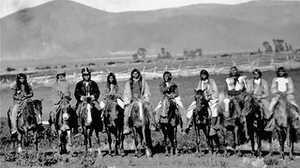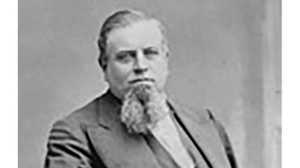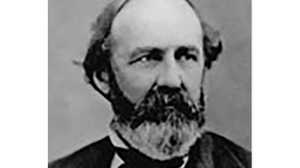Hell on Wheels
"I found as I passed through North Platte that the Indians had driven all the traders and miners in from the mountains," wrote Major Henry C. Parry, en route to a Colorado military outpost. "And at North Platte they were having a good time gambling, drinking, and shooting each other." Massachusetts newspaper editor Samuel Bowles observed the peculiar representatives of American culture taking root in North Platte and christened what he saw Hell on Wheels. The name would stick.
A Spirit of Anarchy
As the press of empire settled down for the winter of 1866, North Platte, Nebraska, took shape at iron's end. Entrepreneurs rushed in to take advantage of the idle labor force. Gambling houses, dance halls, saloons, and brothels, flimsily assembled from wood or canvas, sprang up to cater to the needs -- and empty the pockets -- of railroaders. Miners and traders, scattered across the countryside, converged upon the relative comforts of the new outpost. Regular train service on constructed track brought carloads of migrants looking to settle down, make a buck, or simply experience the zeitgeist of a town perched on the wild's edge. North Platte and towns that followed were the new boomtowns, and like those Pacific coast convergence points of earlier decades, they grew without law. Which, of course, encouraged a spirit of anarchy, not to mention a proliferation of scoundrels.
Pack Up and Follow Along
The most striking feature of these insurgent colonies was their portability. As winter thawed, and the railroaders built toward new towns, agents of vice or enterprise could simply pack up their wares, dismantle their shacks, and follow along on the newly-laid track. If a town dried up once the railroad left -- and many did, for the railroad was where profit resided -- then so be it. North Platte quickly emptied the next year. So did Julesburg, Colorado, which had rebounded from its 1865 destruction to momentarily bustle with railroad energy. In the fall of 1867, journalist Henry Morgan Stanley observed, "Julesburg is now an overdone town, a played out place... It is now about to be abandoned by the transient sojourners, and many of them are shifting their portable shanties to some prospective city west -- Cheyenne, or some 'prairie dog town,' where cash can be made without work..."
Cheyenne
There was profit to be made for the Union Pacific as well. As surveyors moved ahead of the line, they divided prospective towns into lots, which in turn were sold to emigrants carried west by the railroad. It was in the Union Pacific's best interest to imbue a town with permanence, to take "hell" and "wheels" out of the equation. On July 4, 1867, Grenville Dodge picked a location in Wyoming Territory that would become a division point for the Union Pacific. He named it Cheyenne and envisioned a monumental city someday taking form. By year's end it housed thousands, with a nearby military post for its protection. Soldiers were not allowed in town except to remove claim-jumpers from railroad property. Cheyenne was a grander enterprise than previous Hell on Wheels towns, but it still had a bit of rough and tumble in it. A daily column in the Cheyenne Leader reported on "Last Night's Shootings."
Vigilantes in Laramie
Founded in 1869, Corrine, Utah Territory would be the last railroad town to truly embody Hell on Wheels, although depravity would follow the Union Pacific all the way to the track's completion at Promontory Summit, Utah. When Mormon leaders began to worry about the immoral characters escorting the railroad's advance, they were not the first. Often, as Hell on Wheels towns put down roots, the towns' more respectable element grew tired of crime. In May of 1868, the newly-formed town government of Laramie, Wyoming resigned after only three weeks on the job. Anarchy reigned in the streets; murders happened nightly. By October, a vigilance committee of storekeepers and railroad workers declared war, organizing itself to hang an outlaw named The Kid. Retaliation from his gang led to a protracted battle in the streets, during which the vigilantes gained the upper hand. They hung three outlaws from the rafters of a log cabin, and one more from a telegraph pole. The remaining scoundrels were chased out of town.







